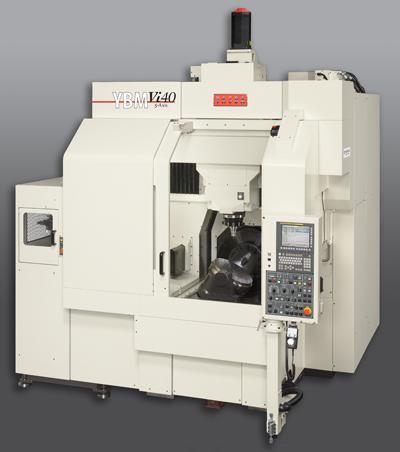
Methods Machine Tools Inc. has introduced the YASDA YBM Vi40 5-Axis Vertical CNC Jig Boring-Milling Machine for high accuracy, hard milling applications of complex dies, molds and components in industries such as aerospace, defense, automotive, medical and electronic. The YBM Vi40 achieves exceptionally high accuracy including simultaneous 5-Axis cone machining circularity of 2.32 µm, .89 µm positioning accuracy of the Y-Axis, and indexing accuracies of ± 0.50 sec on the B-Axis and ± 0.20 sec on the C-Axis. A 24,000 RPM, 40-taper direct-drive spindle offers a high degree of precision throughout the entire speed range.
"We are very pleased to offer a new YASDA 5-Axis solution for complicated part and mold geometries in extremely hard materials, where five axes are more productive than three," said Mr. Steve Previti, YASDA Product Manager, Methods Machine Tools Inc. "The YASDA YBM Vi40 produces surface finishes which meet extremely tight tolerances and do not require secondary finishing operations."
The YBM Vi40 offers 5-sided machining in a single set-up. The number of operations is dramatically reduced by offering 3+2-Axes machining where 3-Axes are simultaneously machining by fixing the index angles of B/C-Axes, as well as 4+1 Axes machining where 4-Axes are simultaneously machining by fixing the index angle of the B-Axis.
Building on the well-known, highly accurate and rigid YBM machine structure, the new Vi40 features a symmetric bridge-type structure, resulting in ultra-high precision when making heavy cuts. Single-piece high-grade cast iron construction, including the column and top beam, increases the rigidity. A highly rigid feed drive system features large diameter ball screws and high-speed interpolation control. Three bearings support a precisely assembled worm gear driven B-Axis, and a highly accurate direct-drive motor is included on the C-Axis.
To reduce thermal distortion and achieve the highest precision 5-Axis machining, including over long production runs, the YBM Vi40 features a thermal distortion stabilizing system where the X-Y-Z axes and two rotational axes (B/C) are maintained to +/-0.2 degrees C to shop ambient. Circulating temperature-controlled oil through the machine minimizes thermal displacement of each axis. A highly rigid and accurate rotary B/C-Axis mounted on the Y-Axis machine bed controls movement and offers machining stability, even when adding up to 400 lbs. of weight including the fixture and part.
An exclusive spindle bearing preload self-adjusting technology provides optimum preload at the full range of spindle speeds. YASDA has developed a mechanism that applies a large preload at low-speed rotation, and the preload decreases according to the amount of heat generated by the spindle bearing at high-speed rotation. A full range of machining is offered, from heavy duty roughing to delicate fine finishing, all while providing a long tool and spindle bearing life.
For efficient, high precision 5-Axis operation, accessibility between spindle and workpiece, and operator and the machining point, has been optimized to reduce distances. Greater work piece access allows for shorter tool lengths thus enabling higher feed rates. A variety of features are offered for ease-of-use including high-speed, smooth TCP; a command for tilted working plane indexing; a rotation center calibrating function and more. Also, standard on the Vi40, CAMplete TruePath software enables analysis, modification, optimization and simulation of 5-Axis tool paths in an integrated 3D environment.
The new YASDA YBM Vi40 has a work envelope with X-Y-Z travels of 35.4" x 19.7" x 17.7" (900mm x 500mm x 450mm), respectively, a vertical rotation of 360Ì¢åÅå¡ and a horizontal rotation of +/- 100Ì¢åÅå¡. An Automatic Tool Changer holds up to 60 tools with an option to hold 100 tools. The powerful, new easy-to-use FANUC FS31i-B5 control is furnished standard.
Contact Details
Related Glossary Terms
- computer numerical control ( CNC)
computer numerical control ( CNC)
Microprocessor-based controller dedicated to a machine tool that permits the creation or modification of parts. Programmed numerical control activates the machine’s servos and spindle drives and controls the various machining operations. See DNC, direct numerical control; NC, numerical control.
- feed
feed
Rate of change of position of the tool as a whole, relative to the workpiece while cutting.
- fixture
fixture
Device, often made in-house, that holds a specific workpiece. See jig; modular fixturing.
- gang cutting ( milling)
gang cutting ( milling)
Machining with several cutters mounted on a single arbor, generally for simultaneous cutting.
- interpolation
interpolation
Process of generating a sufficient number of positioning commands for the servomotors driving the machine tool so the path of the tool closely approximates the ideal path. See CNC, computer numerical control; NC, numerical control.
- jig
jig
Tooling usually considered to be a stationary apparatus. A jig assists in the assembly or manufacture of a part or device. It holds the workpiece while guiding the cutting tool with a bushing. A jig used in subassembly or final assembly might provide assembly aids such as alignments and adjustments. See fixture.
- milling
milling
Machining operation in which metal or other material is removed by applying power to a rotating cutter. In vertical milling, the cutting tool is mounted vertically on the spindle. In horizontal milling, the cutting tool is mounted horizontally, either directly on the spindle or on an arbor. Horizontal milling is further broken down into conventional milling, where the cutter rotates opposite the direction of feed, or “up” into the workpiece; and climb milling, where the cutter rotates in the direction of feed, or “down” into the workpiece. Milling operations include plane or surface milling, endmilling, facemilling, angle milling, form milling and profiling.
- work envelope
work envelope
Cube, sphere, cylinder or other physical space within which the cutting tool is capable of reaching.

